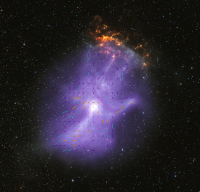IXPE Home: Expanding the X-ray View of the Universe
The Imaging X-ray Polarimetry Explorer (IXPE) exploits the polarization state of light from astrophysical sources to provide insight into our understanding of X-ray production in objects such as neutron stars and pulsar wind nebulae, as well as stellar and supermassive black holes. Launch was December 9, 2021. Technical and science objectives include:
- improving polarization sensitivity by two orders of magnitude over the X-ray polarimeter aboard the Orbiting Solar Observatory OSO-8 (scientists see HEASARC: OSO-8),
- providing simultaneous spectral, spatial, and temporal measurements,
- determining the geometry and the emission mechanism of Active Galactic Nuclei (see Chandra image below) and microquasars,
- finding the magnetic field configuration in magnetars and determining the magnitude of the field,
- finding the mechanism for X ray production in pulsars (both isolated and accreting) and the geometry,
- determining how particles are accelerated in Pulsar-Wind Nebulae.
 This image, referred to colloquially as the Cosmic Hand and in scientific circles as the pulsar-wind nebula MSH 15-52, has been created from a space-based telescope, Chandra X-ray Observatory, and an Earth-based one in Chile known as Blanco.
The colors represent X rays detected by Chandra (purple), with red representing infrared light acquired with the Dark Energy Camera Plane Survey 2 (DECaPS2), an instrument on the Blanco telescope. The arrows (click on the image for a larger version) represent polarization data from IXPE. More information may be found here:
NASA Press Release.
This image, referred to colloquially as the Cosmic Hand and in scientific circles as the pulsar-wind nebula MSH 15-52, has been created from a space-based telescope, Chandra X-ray Observatory, and an Earth-based one in Chile known as Blanco.
The colors represent X rays detected by Chandra (purple), with red representing infrared light acquired with the Dark Energy Camera Plane Survey 2 (DECaPS2), an instrument on the Blanco telescope. The arrows (click on the image for a larger version) represent polarization data from IXPE. More information may be found here:
NASA Press Release.
*Click HERE to access the bibliographic references to IXPE Discovery Papers published to date (November 2023). For a bibliography of all IXPE papers, please visit NASA's HEASARC Bibliography Search Pages.

